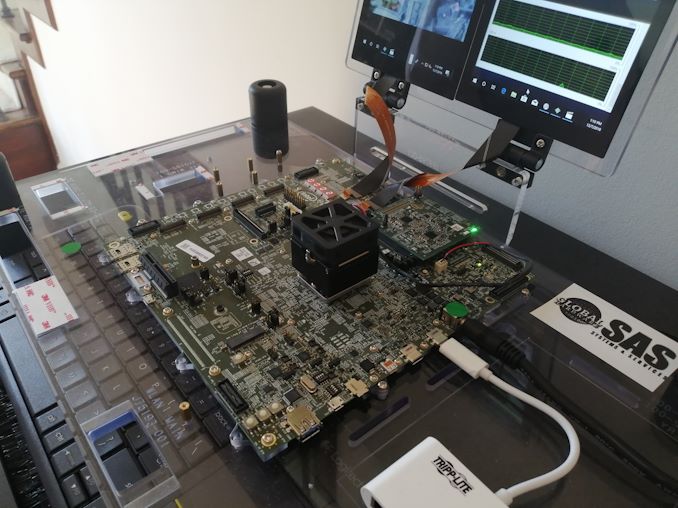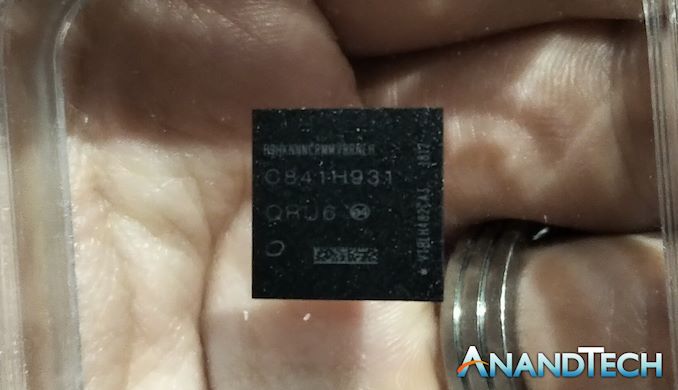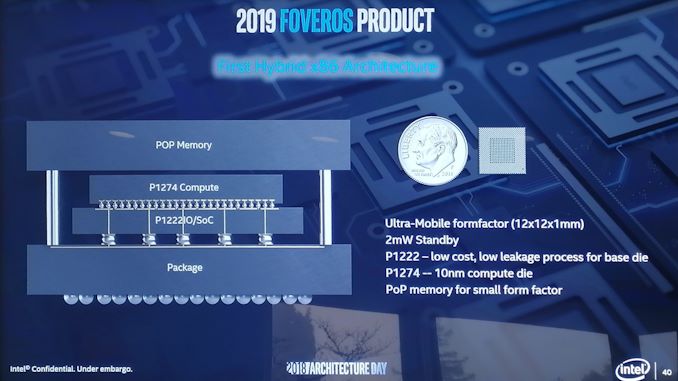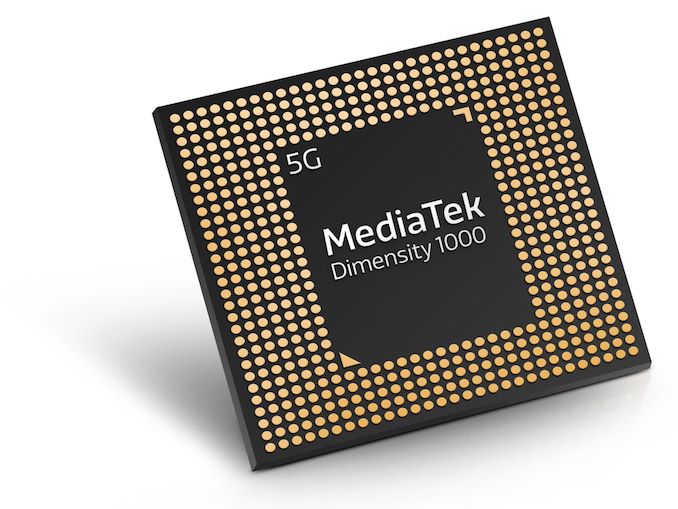Intel: Lakefield in 2020, Possible 5G on Foveros
by Dr. Ian Cutress on December 11, 2019 1:15 PM EST
Update: Intel has sent over a statement clarifying that Lakefield will begin showing up in retail devices in 2020. And in particular that we should expect to see Lakefield devices as part of the Holiday 2020 device refreshes. Intel has stated that the comments made at the event were not specifically talking about a 'Lakefield Refresh' product, but a line of 'refresh products' based on Lakefield, and that we misheard the engineer's comments. It should be noted however that we have parity from other press in the room of our interpretation of the comments made.
At the IEEE International Electron Devices Meeting (IEDM) 2019, Intel had two package integration presentations, one on its Omni-Directional Interconnect and one on its 3D stacking Foveros technology. In the first talk, one of Intel’s engineers presenting at the conference said a rather curious thing that hasn’t been previously disclosed.
One of the highlights of 2019 as a whole has been Intel’s disclosures about its new 3D stacking, or ‘Foveros’, technology. The idea here is that using multiple silicon dies stacked on top of each other, you can decrease the overall die size of a chip but also increase the bandwidth if one of the silicon dies is dedicated to cache or memory. In the case of Intel’s first Foveros chip, Lakefield, we have one IO die and one compute die on different process nodes stacked together with additional PoP memory on top of the stacked design. Lakefield has been announced for two products so far, the Samsung Galaxy Book S and the Microsoft Surface Neo, both of which are scheduled to come to market in mid-2020.
Intel’s second announced Foveros chip is its new Xe-HPC architecture based graphics card design for high performance computing. Given the code name ‘Ponte Vecchio’, the new GPU is slated for a late 2021 launch and will use Foveros technology to help build out compute performance across 8 compute dies per slide, and Ponte Vecchio will have two slices per GPU. This GPU is being built primarily for the exascale-class Aurora supercomputer, which is set to be installed in the Argonne National Laboratories in 2021.
So what was the off-hand comment made at IEDM this year? On stage, an Intel Principle Engineer stated that by Holiday 2020, we should expect to see Lakefield Refresh based devices in the market. The engineer did state that first generation of Lakefield was already shipping, and that we should expect to see the next refresh of hardware/devices in finished consumer products by the end of 2020.
Intel is betting on its new Foveros technology, as with its EMIB interconnects, as a corner stone of certain areas of its product portfolio as we roll into the new decade. It will be interesting to see if the cost can be amortized into more price-sensitive areas. During the same IEDM presentation, the same principle engineer also mentioned that the Foveros stacking technology can also lend itself to adding on a modem into that stack – given that Intel recently announced a partnership with Mediatek to provide 5G connectivity for its products, one can make the assumption that at some point we’ll see a Foveros product with a modem too.
Hopefully Intel will disclose more in the early part of 2020.
Related Reading
- CES 2019 Quick Bytes: Intel’s 10nm Hybrid x86 Foveros Chip is Called Lakefield
- Intel's Interconnected Future: Combining Chiplets, EMIB, and Foveros
- Hot Chips 31 Live Blogs: Intel Lakefield and Foveros
- Intel’s Xe for HPC: Ponte Vecchio with Chiplets, EMIB, and Foveros on 7nm, Coming 2021
- Intel's new Atom Microarchitecture: The Tremont Core in Lakefield
- Samsung Develops Intel Lakefield-Based Galaxy Book S: Always-Connected x86 PC
- MediaTek Announces Dimensity 1000 SoC: Back To The High-End With 5G
- Intel and MediaTek Announce Partnership To Bring 5G Modems to PCs













37 Comments
View All Comments
trivik12 - Sunday, December 15, 2019 - link
you should see the Microsoft surface laptop review comparing custom AMD chip with icelake. It was complete ass whippage from intel.Korguz - Sunday, December 15, 2019 - link
as was said in the article comments for this.. it may have been but a few are questioning the results.i guess intel has to do that some where, its getting its own butt handed to it every where else.
Santoval - Thursday, December 12, 2019 - link
There is a reason that HVM (high volume manufacturing) is generally considered the only true release, while everything else is considered little more than sampling. There is nothing suggesting that Intel is releasing Ice Lake-U/Y at high volume. If anything, the dual release with Comet Lake-U/Y along with the fact that they have not yet ramped up 10nm manufacturing (I believe they have only two 10nm fabs) suggests that Ice Lake machines will be far fewer than Comet Lake ones. I wonder, out of each 5 laptops and ultra-portables that hit the market will 1 of them (Project Athena certified) have an Ice Lake-U/Y or am I being a bit generous?Drumsticks - Thursday, December 12, 2019 - link
I don't see why ice lake really needs to be in high volume, though. It's a premium part for sure, and it's bound for ultrabooks. Every icelake configuration of the Dell XPS 13 2in1 looks to be in stock on Dell.com. Same for the Surface Pro 7 on Microsoft Store and best buy. I think Lenovo has some icelake laptops too, although I don't know about HP.What exactly qualifies as high volume? Sure, 10nm doesn't currently cover every segment of the market, but it legitimately covers the premium segment that it needs to without apparent supply shortages. Intel might have 14nm covering the budget markets, but that's not surprising, because they're budget markets.
Fataliity - Thursday, December 12, 2019 - link
It's in stock because it is worse in all ways. If your going premium, you better off with a 6 core 14nm part with a discrete nvidia gpu. That's premium. Their Ice Lakes are overpriced and just bad. see above comment.tecknohow - Thursday, December 12, 2019 - link
I'm finding these relative discussions about what "high volume" actually means to be very amusing. AMD's overall sales volume is literally 1/10th of Intel's and the number of CPU shipments is bound to be similar. I wouldn't be surprised if Intel actually sells close to as many or even more Ice Lake-U/Y chips than AMD does their entire Ryzen stack. That has nothing to do with who is making better chips, it's just an economic reality. Just because it's not going to be as high volume as some of Intel's other lines doesn't at all mean it's not high volume production.Oh and for the record stock on the XPS 13 2-in-1 and some other Ice Lake laptops has been very tight with sometimes multi-week lead times. I know because I've been ordering a bunch of them for various customers.
Korguz - Thursday, December 12, 2019 - link
tecknohow you are comparing a low volume part, to ALL of AMDs products ?? might want to rethink that... and high volume, means mainstream products, which the 10nm parts are not mainstream. " and some other Ice Lake laptops has been very tight with sometimes multi-week lead times " probably because the 10nm process still has low yields, and intel can't make very many of them as of yet.ksec - Thursday, December 12, 2019 - link
> but it legitimately covers the premium segment that it needs to *without apparent supply shortages*.That is because
1. Intel has been stock piling these chip for holiday release, so those vendor gets the chip.
2. The major player in premium market ( That defined as $1000+ ) is still not getting Icelake. And that is Apple.
Is it on the street, yes. Are they in high volume? I have serious doubt.
Farfolomew - Monday, December 16, 2019 - link
IceLake processors are in a lot of devices now being sold. There's several models of cheap laptops ($350 low end) that have Core i3-10xxG1 parts, and several more in the $400-$500 range that have i5 IceLake parts.These are not going into just Ultrabooks and premium laptops, they're already in budge laptops and I imagine are beginning to fill out the market.
Santoval - Thursday, December 12, 2019 - link
Realistically you can't (not "right now" anyway), due to the very low volume of machines with Ice Lake-U/Y compared to the ones with Comet Lake-U/Y, which are going to be the major bulk of this dual release. Low volume, assuming there is demand, means long waiting when pre-ordering, and pre-ordering *far* in advance will probably be the only way to get anything with Ice Lake.Furthermore, the dual release combined with the low availability of machines with Ice Lake-U/Y will artificially inflate their price. They will not equip any non Project Athena machines, and these ones are going to cost an arm and a leg. That despite the capping of CPU cores to 4, the roughly equal (in some tests lower in some other higher) CPU performance to Whiskey/Amber Lake, the slightly *slower* CPU performance than the equivalent (4-core) Comet Lake CPUs (the IPC is up to 18% higher but the clocks ate all of the IPC gains because, you guessed it, they are ~18% lower) and the *much* lower performance than the 6-core ones.
On the other hand the Gen11 iGPU will be quite faster (the 48+ core ones anyway), there is quite faster DRAM support and an embedded Thunderbolt controller. Since the power efficiency is arguably the same or worse (worse for the -Y parts), despite the switch to 10nm, Intel will ask much more money just for these last few bits. Are they really worth it? Oh, let's not forget : for the .... newer AI engine and the Wi-Fi 6 support as well!